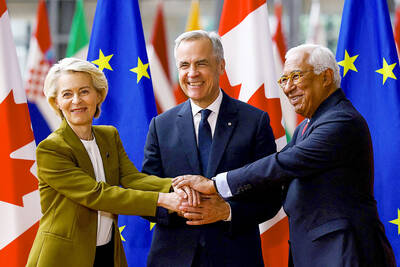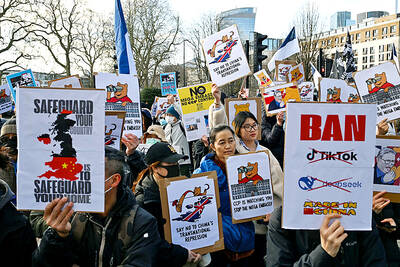For many months, coalition military planners in Afghanistan have been readying themselves for a bloody summer. In briefings in the spring, a number of officers — from the then-commander of coalition forces, David McKiernan, to company commanders patrolling sullen villages — all said significant casualties in the traditional “fighting season” of July and August were inevitable. Nor were casualties likely to be because of greater numbers of troops coming into the country and venturing into new areas.
“The Taliban are much, much more stood up. They are much tighter, much more professional, much more together,” one intelligence officer in Kabul said earlier this year.
A lot has been made of the Taliban’s increasing use of “asymmetric tactics,” such as booby traps, roadside bombs or suicide attacks. A few hours on an operation with US troops, supported by attack helicopters, jets and unmanned heavily armed drones, makes it clear why: If the insurgents do not stay out of the way, they will be killed, as many thousands have been.
But once coalition troops establish a presence, they become vulnerable. They need supplies, they need to patrol; they are perfect targets for the hit and run tactics of the Taliban.
Those tactics have been particularly honed in ambushes. Soldiers fighting the insurgents say they now show vastly improved ability to coordinate fire. So volleys of rocket-propelled grenades (RPGs) now rain down during engagements.
The Taliban have also learned to focus fire on their opponents’ heavy weapons or radios. NATO officers also say the Taliban’s command and control has also been improved to coordinate fighting with foot soldiers and to allow rapid engagement or disengagement.
US soldiers who served in Iraq say Afghan fighters compared favorably to the disorganized militants they had faced before. They say they are often more imaginative, too. In one engagement in Kunar Province last year, insurgents got close enough to US positions to throw stones among them, hoping the US troops would mistake them for grenades, panic and expose themselves.
Yet the work done by the Taliban high command — based mainly in Pakistan — goes way beyond tactics. Through the winter, NATO intelligence officers say, the insurgents worked at stiffening internal discipline. Several Afghan members of parliament interviewed earlier this year say the shadow governors appointed by the Taliban in every province were reshuffled to re-energize the movement.
Junior frontline commanders, many of whom had become more autonomous in last year’s fighting and challenged their leadership, were brought in line.
Teams organizing the bombs that have caused so many of the casualties were retrained in new techniques. Spies and double agents were killed.
The tactics of the coalition forces have been studied closely. One preoccupation is air power. As with the conflict with the Soviets, airpower is what insurgents fear most. Helicopters have not yet been attacked successfully in a systematic way.
However, if the Taliban do find a means to target coalition aircraft, this will not simply change tactics but geopolitics — as it did for the Soviets. Within three years of the Afghan mujahidin receiving effective surface-to-air missiles, the Soviets had pulled out.

The team behind the long-awaited Vera Rubin Observatory in Chile yesterday published their first images, revealing breathtaking views of star-forming regions as well as distant galaxies. More than two decades in the making, the giant US-funded telescope sits perched at the summit of Cerro Pachon in central Chile, where dark skies and dry air provide ideal conditions for observing the cosmos. One of the debut images is a composite of 678 exposures taken over just seven hours, capturing the Trifid Nebula and the Lagoon Nebula — both several thousand light-years from Earth — glowing in vivid pinks against orange-red backdrops. The new image

Canada and the EU on Monday signed a defense and security pact as the transatlantic partners seek to better confront Russia, with worries over Washington’s reliability under US President Donald Trump. The deal was announced after a summit in Brussels between Canadian Prime Minister Mark Carney and European Commission President Ursula von der Leyen and European Council President Antonio Costa. “While NATO remains the cornerstone of our collective defense, this partnership will allow us to strengthen our preparedness ... to invest more and to invest smarter,” Costa told a news conference. “It opens new opportunities for companies on both sides of the

ESPIONAGE: The British government’s decision on the proposed embassy hinges on the security of underground data cables, a former diplomat has said A US intervention over China’s proposed new embassy in London has thrown a potential resolution “up in the air,” campaigners have said, amid concerns over the site’s proximity to a sensitive hub of critical communication cables. The furor over a new “super-embassy” on the edge of London’s financial district was reignited last week when the White House said it was “deeply concerned” over potential Chinese access to “the sensitive communications of one of our closest allies.” The Dutch parliament has also raised concerns about Beijing’s ideal location of Royal Mint Court, on the edge of the City of London, which has so

OVERHAUL: The move would likely mark the end to Voice of America, which was founded in 1942 to counter Nazi propaganda and operated in nearly 50 languages The parent agency of Voice of America (VOA) on Friday said it had issued termination notices to more than 639 more staff, completing an 85 percent decrease in personnel since March and effectively spelling the end of a broadcasting network founded to counter Nazi propaganda. US Agency for Global Media (USAGM) senior advisor Kari Lake said the staff reduction meant 1,400 positions had been eliminated as part of US President Donald Trump’s agenda to cut staffing at the agency to a statutory minimum. “Reduction in Force Termination Notices were sent to 639 employees at USAGM and Voice of America, part of a